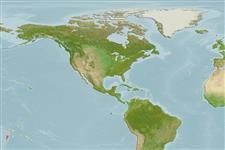>
Blenniiformes (Blennies) >
Blenniidae (Combtooth blennies) > Blenniinae
Etymology: Meiacanthus: Greek, meion = less = lessen + Greek, akantha = thorn (Ref. 45335); tongaensis: Specific epithet refers to Tonga Is., where it appears to be endemic..
Environment: milieu / climate zone / depth range / distribution range
Ecología
marino; rango de profundidad 0 - 16 m (Ref. 7401). Tropical
Pacific Ocean: apparently endemic to Tonga.
Tamaño / Peso / Age
Maturity: Lm ? range ? - ? cm
Max length : 10.0 cm SL macho / no sexado; (Ref. 54980)
Espinas dorsales (total): 4; Radios blandos dorsales (total): 27-28; Espinas anales 2; Radios blandos anales: 17 - 18. Lunate caudal fin with elongated lobes in adults; yellowish green on head and dorsally on body, shading to light yellow ventrally; greenish yellow dorsal and anal fins, broad black stripe near dorsal fin base; caudal fin base and lobes greenish yellow with centroposterior part transparent with pale greenish yellow rays. Segmented caudal rays 11-12 (usually 11); lateral line terminating below 3rd to 7th dorsal soft rays (Ref. 54980).
Oviparous. Eggs are demersal and adhesive (Ref. 205), and are attached to the substrate via a filamentous, adhesive pad or pedestal (Ref. 94114). Larvae are planktonic, often found in shallow, coastal waters (Ref. 94114).
Life cycle and mating behavior
Madurez | Reproducción | Puesta | Huevos | Fecundidad | Larva
Oviparous, distinct pairing (Ref. 205).
Smith-Vaniz, W.F., 1987. The saber-toothed blennies, tribe Nemophini (Pisces: Bleniidae): an update. Proc. Acad. Nat. Sci. Philad. 139:1-52. (Ref. 7401)
IUCN Red List Status (Ref. 130435)
Threat to humans
Harmless
Human uses
Más información
Age/SizeCrecimientoLength-weightLength-lengthLength-frequenciesMorfometríaMorfologíaLarvaDinámica larvariaReclutamientoAbundanciaBRUVS
ReferenciasAcuiculturaPerfil de acuiculturaRazasGenéticaElectrophoresesheritabilidadEnfermedadesProcesamientoNutrientsMass conversion
ColaboradoresImágenesStamps, Coins Misc.SonidosCiguateraVelocidadTipo de nataciónSuperficie branquialOtolitosCerebrosVisión
Herramientas
Special reports
Download XML
Fuentes de Internet
Estimates based on models
Preferred temperature (Ref.
123201): 25.6 - 29.1, mean 28.1 °C (based on 91 cells).
Phylogenetic diversity index (Ref.
82804): PD
50 = 0.5000 [Uniqueness, from 0.5 = low to 2.0 = high].
Bayesian length-weight: a=0.00562 (0.00258 - 0.01228), b=3.06 (2.87 - 3.25), in cm total length, based on LWR estimates for this (Sub)family-body shape (Ref.
93245).
Nivel trófico (Ref.
69278): 3.5 ±0.5 se; based on size and trophs of closest relatives
Resiliencia (Ref.
120179): Alto, población duplicada en un tiempo mínimo inferior a 15 meses (Preliminary K or Fecundity.).
Fishing Vulnerability (Ref.
59153): Low vulnerability (10 of 100).
Nutrients (Ref.
124155): Calcium = 396 [203, 771] mg/100g; Iron = 1.91 [1.10, 3.39] mg/100g; Protein = 17.5 [16.2, 18.5] %; Omega3 = 0.152 [0.074, 0.313] g/100g; Selenium = 26.5 [11.0, 63.6] μg/100g; VitaminA = 64.1 [18.4, 225.5] μg/100g; Zinc = 2.33 [1.54, 3.42] mg/100g (wet weight);
